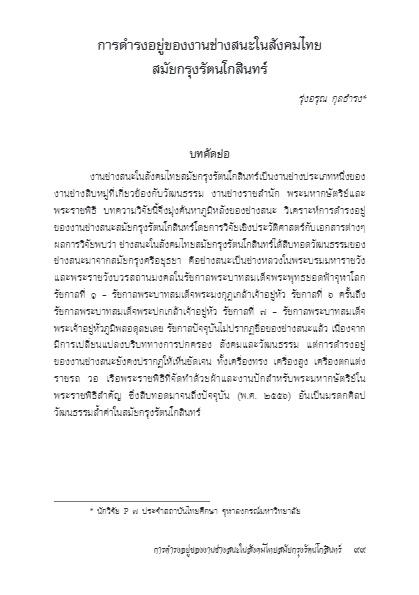รุ่งอรุณ กุลธำรง
บทคัดย่อ
งานช่างสนะในสังคมไทยสมัยกรุงรัตนโกสินทร์เป็นงานช่างประเภทหนึ่งของงานช่างสิบหมู่ที่เกี่ยวข้องกับวัฒนธรรม งานช่างราชสำนัก พระมหากษัตริย์ และพระราชพิธี บทความวิจัยนี้จึงมุ่งค้นหาภูมิหลังของช่างสนะ วิเคราะห์การดำรงอยู่ของงานช่างสนะสมัยกรุงรัตนโกสินทร์โดยการวิจัยเชิงประวัติศาสตร์กับเอกสารต่างๆ ผลการวิจัยพบว่า ช่างสนะในสังคมไทยสมัยกรุงรัตนโกสินทร์ได้สืบทอดวัฒนธรรมของช่างสนะมาจากสมัยกรุงศรีอยุธยา คือช่างสนะเป็นช่างหลวงในพระบรมมหาราชวังและพระราชวังบวรสถานมงคลในรัชกาลพระบาทสมเด็จพระพุทธยอดฟ้าจุฬาโลก รัชกาลที่ 1 – รัชกาลพระบาทสมเด็จพระมงกุฎเกล้าเจ้าอยู่หัว รัชกาลที่ 6 ครั้นถึงรัชกาลพระบาทสมเด็จพระปกเกล้าเจ้าอยู่หัว รัชกาลที่ 7 – รัชกาลพระบาทสมเด็จพระเจ้าอยู่หัวภูมิพลอดุลยเดช รัชกาลปัจจุบันไม่ปรากฏชื่อของช่างสนะแล้ว เนื่องจากมีการเปลี่ยนแปลงบริบททางการปกครอง สังคมและวัฒนธรรม แต่การดำรงอยู่ของงานช่างสนะยังคงปรากฏให้เห็นชัดเจน ทั้งเครื่องทรง เครื่องสูง เครื่องตกแต่งราชรถ วอ เรือพระราชพิธีที่จัดทำด้วยผ้าและงานปักสำหรับพระมหากษัตริย์ในพระราชพิธีสำคัญ ซึ่งสืบทอดมาจนถึงปัจจุบัน (พ.ศ. ๒๕๕๖) อันเป็นมรดกศิลปวัฒนธรรมล้ำค่าในสมัยกรุงรัตนโกสินทร์
(ตีพิมพ์ใน วารสารไทยศึกษา ปีที่ 9 ฉบับที่ 2 (สิงหาคม 2556 – มกราคม 2557) หน้า 99-130)
The Existence of Chang Sa-na or Sewing Work in Thai Society in the Rattanakosin Era
Rungaroon Kulthamrong
Abstract
Chang Sa-na (sewing work) in Thai society in the Rattanakosin Era is one category of handcraft in the traditional Ten Thai Crafts encompassed in the culture and court inspired craftsmanship of the king for royal ceremonies. This article aims to search the tradition of Chang Sa-na and to analyze the existence and performance of the practices of Chang Sa-na by an historical analytical approach and documentary research. The research results reveal that Chang Sa-na craft in the Rattanakosin Era has inherited the traditional cultural craft practices from the Ayutthaya period. Chang Sa-na had been craftsmanship under the royal patronage of the Grand Palace and the Front Palace in the reign of King Rama I onward to the reign of King Rama VI. Then, during the reign of King Rama VII to the reign of King Rama IX, or the contemporary King, Chang Sa-na has disappeared because of the changing context of political administration, society and culture. However, the existence of the craft of Chang Sa-na has continued to be practiced in royal dress (Khrueang Song), royal regalia (Khruang Sung), ornamentation of ceremonial vehicles, ceremonial palanquins, and royal barges decorated with cloth and embroidery for the King in important royal ceremonies. This reflects the cultural inheritance existing in the contemporary time with respect to valuable art and cultural heritage in the Rattanakosin Era.
(Published in Journal of Thai Studies Volume 9 Number 2 (August 2013 – January 2014) Page 99-130)
บทความ / Full Text : Download
